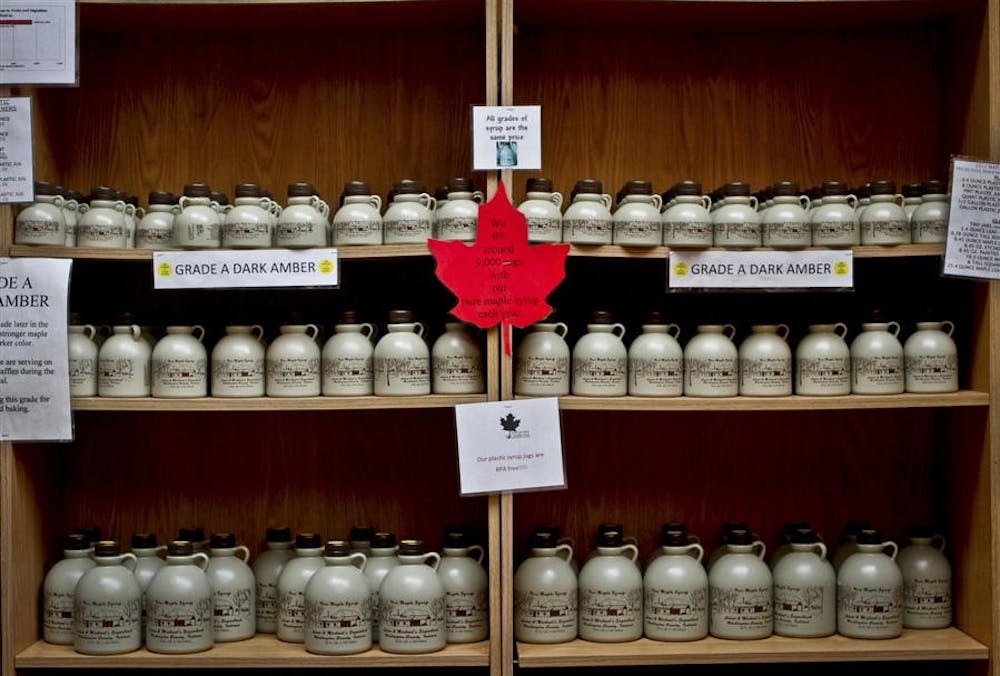A white, 5-gallon bucket rested at the foot of a maple tree on Michael Goering’s farm in Salem, Ind., a piece of tubing hanging from the tree into a bucket. It’s the old-school way of making maple syrup, though some could use the same term for the 14-mile tubing method Michael now utilizes.
Michael’s syrup isn’t the kind found on grocery store shelves. It’s the kind made directly from the tree’s sap, not processed with corn syrup or other flavoring. It’s the kind that works on a grading system — the darker the color, the fuller the flavor — and that still has sugars and trace elements in each cup.
It’s the kind Michael likes to show off every year to thousands of visitors from across the country at his family’s Maple Syrup Festival.
“There are probably 3,000 or 4,000 people here today,” he said. “Last year, I know there were about 2,000 people here a day, and I know there’s more than that this year.”
On Feb. 25, Michael led a group of about 20 people on a tour of where the syrup process starts, as sap in the 1,900 maple trees on his property. He stopped by a tree and took a blue spile out of one of the tree’s tapholes. The spile, a plastic spout, draws sap from the tree into lateral lines that carry the sap through vacuum pumps. That way, all the sap from trees in the area is collected in the same place — in tanks in the middle of the woods instead of in separate 5-gallon buckets.
It’s a process that has been modernized since Michael began making syrup with his wife, Leane, in 1981.
“I personally have always had a love of making food out of a tree,” he said. “The concept of that is fascinating to me.”
In 1983, the couple made its business commercial as Leane and Michael’s Sugarbush. But it took four more years to figure out production. In 1987, the two produced more than 1,000 gallons of syrup for the first time in a single season. This season, they are near 16,000 gallons.
Hearing Michael explain the process on the tour, it sounds easier than it looks. But his crew has been doing this for years. They have it down to an art.
ON THE FARM
The Goerings started their business cold, with Leane and Michael as the first generation. Now, it’s a family lifestyle.
“I like to say I was born into the maple syrup business,” said Emily Blackman, Michael and Leane’s second oldest daughter.
Emily was born March 3 at the end of syrup season. Every two or three years, including this year, the festival lands on her birthday.
“When people ask what your parents do, I say, ‘They make maple syrup,’” she said. “I get weird looks. Most people think of Vermont and Canada when they think maple syrup.”
Michael said he knows the syrup production is less of a way to make money than it is a way to keep his life balanced. Working primarily as a civil engineer, Michael said he really just enjoys making maple syrup.
“It’s not enough for me to make a living on just doing that, but it is profitable,” he said. “I’m an engineer. Engineering is very profitable. But I do like doing this.”
Standing at the edge of his driveway, Michael can see most of the buildings he’d built by hand since moving onto the farm. His two-story house. A three-room store. The syrup production workshop. There are more, but he doesn’t know how many. He’s never counted.
“You can tell how the business has grown by the tin on the roof of the store,” Emily said. “The first part that was built has the darkest tin, and you can see where we added on.”
Michael begins syrup season in early February, when the weather is cold enough that temperatures fall below freezing at night and rise again during the day. Without fluctuating temperatures, sap will not run.
After entering the tanks in the woods, the sap is transported to a feed tank in the Goerings’ main production building, then moved to an evaporator, where the sap is boiled. The sap zig-zags back and forth through metal rows, pushing solids — or sugars and other trace elements — out of the sap through small holes in the metal. When it gets to the end, that’s the syrup Michael bottles.
It’s a long process, but Michael has help.
Josh Hall works on the Goering farm for rent. He lives with his wife in a log cabin on the property and has helped Michael with nearly every step of the syrup-making process for the last eight years.
Before the syrup season, he helped Michael split wood to use in the evaporator. Riding into the woods, Josh sat in the bed of the truck while Michael drove with his spaniel, Clancy, in the passenger seat.
“Something happened between him and a car once,” Michael said of Clancy. “I don’t want to get him flattened.”
Between 9 a.m. and 4:30 p.m., the two brought in load after load of wood and broke two axes. Michael paused as Josh lifted part of a chopped-up green hickory tree.
“You’re not going to try and lift that, are you?” Michael asked.
“Yeah,” Josh said.
“Gosh, I’m impressed,” Michael said.
Michael said he likes having Josh and other volunteers around to do the lifting. He can’t lift things like he used to. But despite aging, he said he loves making maple syrup. There’s an art to it.
Processing techniques can account for differences in a syrup’s flavor and color, but soil type, tree genetics and weather conditions also have something to do with it.
“And for some reason, with the soil type, you have different local flavors,” Michael said. “I can actually taste a difference between Orange County, Jackson County. The sap is affected by your soil, so that eventually carries through to the syrup. It’s a very subtle difference, and you can only really taste it if the syrup’s not real sweet.”
AT THE FESTIVAL
The festival started as a one-weekend pancake festival in 1991. The next year it was changed to the Annual Maple Syrup Festival and was scheduled for two weekends, the last of February and the first of March.
The dates coincide with syrup season, but Michael said it’s also a chance for families to get their children outside before spring. With a candle-making booth, a llama petting area and a scavenger hunt that requires kids to search for small items on the property, the festival offers a variety of entertainment.
Larry Padgett and his wife brought their two children to the festival Saturday for the fourth year in a row, now a family tradition.
“It’s a neat operation, making maple syrup,” Larry said. “It’s a great outside event in the winter months.”
Sadie Padgett, 5, stood near her mother at the candle-making booth. She dipped a pink candle between two jars of wax, an easy task.
“I take this thing and go back and forth,” she said, holding a stick with the candle attached to it.
She said she liked making the candle because she could make it any shape.
“You can set it down wherever you want,” she said of the finished candle. “You can make it really flat.”
But she wasn’t so sure the candle would turn out the way she wanted.
“I’m going to have an awkward candle,” she said.
Despite the extra booths and events at the festival, the heart of the two-weekend event is the syrup, and even if guests don’t leave with a pint of Michael’s homemade product, they usually carry away the smell of it on their shirts or the taste of it on their tongues.
“Two years ago, I got a call at the house from someone asking if the festival was still on because they were flying in,” said Patti Calliway, who worked the information booth Saturday at the festival. “I said, ‘Are you doing anything else when you get here?’ and they said no, they’re just coming to the festival.”
Family continues making homemade maple syrup to sell during festival

Get stories like this in your inbox
Subscribe





